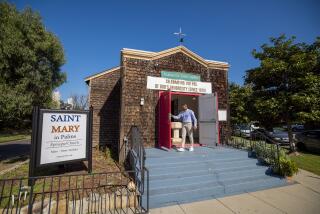Students Search for Greek Row
It was Friday afternoon in Long Beach, a time traditionally reserved for leisure at the Sigma Alpha Epsilon fraternity house.
In the expansive living room of the old two-story structure on Anaheim Street, a group of California State University, Long Beach, students took turns tossing bottle caps into water glasses. Out on the front lawn, a young couple sat carving a Halloween pumpkin. And in the old-fashioned kitchen, a gaggle of Greeks leaned against the rickety cabinets talking excitedly of their weekend plans.
But high in an upstairs parlor, piled vertically against a back wall, a stack of empty cardboard boxes told a different story.
For the 13 SAEs who live here and the more than 60 who call it their house, the day of reckoning has almost arrived. They have been ordered to get out by Nov. 17. Less than a week later, a wrecking ball will raze the structure to make way for a 19-unit luxury apartment complex. And in two years of looking, fraternity officers say, they have been unable to find a place to move.
Restrictive Zoning
The reason: a city zoning ordinance that makes it virtually impossible for fraternities and sororities to relocate or start new houses in Long Beach. Their proposed solution: creation of a fraternity row near the campus where the Greek tradition can flourish.
âIf we donât have a place, the (fraternity) could come to a standstill,â said Eric Nickel, 21, the president of SAE, which has occupied the house on Anaheim since 1979.
Since the new zoning law was enacted seven years ago, three local fraternity chapters--two newly formed and a third that has been around for some time but recently lost its home--have been unable to find housing in the city. And the 14 other fraternities and sororities, authorized by their national offices to maintain houses in Long Beach, exist in a legal limbo that allows them to stay in these residences for as long as they can, but prevents them from ever moving.
The irony, according to Stuart Farber, the universityâs assistant vice president for student services, is that all this is happening when interest in campus Greek life is at an all-time high. The universityâs 26 recognized sororities and fraternities, with a combined active membership of about 1,600, he said, represent a 30% increase over the membership five years ago. âThe students today find a strong need to meet friends and identify with others,â Farber said.
SAEâs problems date back almost to its purchase of the building, which previously served as an accountantâs office and, before that, was a residence for 25 years.
âBordering on Disgustingâ
âIt was bordering on disgustingâ is how Bob Welch, 42, who lives on Granada Avenue about a block from the frat house, describes the early impact of the fraternityâs presence on his neighborhood. âThere was no thought that anyone else lived here. It was a real problem.â
Eventually, he said, residents formed a homeowners association for the express purpose of complaining to both the city and the university regarding the parking problems, excess noise and âunacceptableâ behavior.
As a result, in 1983 the fraternity was put on a yearâs probation, during which members were not allowed to hold social events at the house and were required to participate in a variety of service activities.
Welch said the neighborhood disturbances have greatly diminished since then. And Nap Harris, the universityâs assistant director of student affairs, said that SAE is now the most active fraternity on campus in its involvement in community service projects.
But solutions to the fraternityâs financial problems proved more elusive. Two-and-a-half years ago, said Steve Berbower, an SAE alumnus and president of the fraternityâs housing corporation, the organization was forced to sell its Anaheim Street house to a developer. âWe simply took too big a bite and couldnât make the payments,â Berbower said. âWe were overextended.â
So the fraternity signed a lease-back agreement with the new owner and began searching for another permanent home. They have been unable to find one, officers said, because of the zoning ordinance that took effect after the 1979 purchase.
City Review
Under the ordinance, fraternities and sororities wishing to establish houses in commercial or residential zones must first apply for conditional-use permits subject to approval by the cityâs Planning Commission and, ultimately, the City Council, said Dennis Eschen, the cityâs zoning officer. Previously, he said, communal living situations were allowed only in commercial zones but did not require conditional-use permits. As part of the application process for such permits, Eschen said, all residents within 300 feet of a proposed site are now notified and invited to express their views at a public hearing. And among the cityâs new requirements is that a proposed fraternity or sorority site have one parking space for each bed.
The result has been twofold, said Kathy Graham, housing committee chairman of the universityâs Greek Alumnae Advisory Council. First, she said, available sites containing adequate parking space have become virtually impossible to find. And second, she said, every time a public hearing is held, it âbrings people out of the wall because theyâve all seen âAnimal Houseâ and they think, gosh darn, thatâs not going to happen here.â
To facilitate the heightened interest in fraternity life and at the same time satisfy residents who have for years railed against the fraternity and sorority houses in their neighborhoods, the Greek Alumnae Council is negotiating with the state Department of Transportation for the lease of four acres owned by the agency near the university on which to establish a Greek row.
Because the land--at the intersection of 7th Street and Studebaker Road--is in a non-residential setting, said Graham, the Greek council hopes to persuade the city to permit construction of as many as 20 houses at the site at a projected cost of $150,000 to $175,000 each.
Although financing for the project has not yet been worked out, she said, it is possible that each participating fraternity or sorority could pay its own way, with the first houses reaching completion in 18 to 24 months.
Immediate Concerns
âItâs a win-win-win situation,â Graham said of the proposal, which so far has inspired no organized opposition.
Said Eschen, âIâm in favor of them all being together.â
Back at SAE, though, the focus is on more immediate concerns. Like where will residents be sleeping in less than three weeks when their house will no longer be habitable.
âI might have to go back home,â said Craig Wilkerson, 19, who left his parentsâ abode in nearby Los Alamitos 1 1/2 years ago to move into a $100-a-month room at the fraternity house. With little or no income, he said, he may not be able to afford an apartment, and âhaving to deal with my parentsâ rules and stuff (will be) real hard.â
Said Tom Henry, 20, who is also facing the prospect of returning to the house of his parents: âI hate leaving. Itâs great here--thereâs always something going on.â
These days a lot of whatâs going on involves the storage of various fraternity relics, like the pair of huge concrete, gold-painted lions that guard the buildingâs front door.
Fraternity members say their house was built in 1888 and once housed the foreman of the Bixby ranch, a claim which the cityâs Cultural Heritage Commission has been unable to verify. Nor has the commission been able to find anyone with the means and willingness to finance the removal of the house to a more appropriate historical site, despite an offer by developer Roland Spongberg of Spongberg, Kirkland & Associates to donate the structure to someone interested in restoring it.
âWonderful old houses are being demolished all over Long Beach,â said Rita Woodbury, chairman of the Cultural Heritage Commission, âand the few people who have the resources to save them have a lot to choose from.â Because years of fraternity use resulted in the removal of most of the old houseâs original interior fittings, she said, it does not merit designation as a historical landmark. Most prospective saviors âare going to choose (a house) that is more intact,â she said.
So the probable end for the old place is the wrecking ball.
Fraternity members say they plan to usher it out in true fraternity fashion: with a demolition party. âWe want to get a few kegs, sit across the street and watch the place go down,â Henry said. âWe wonât be able to bring our kids back here. Itâs kind of sad.â
More to Read
Sign up for Essential California
The most important California stories and recommendations in your inbox every morning.
You may occasionally receive promotional content from the Los Angeles Times.










